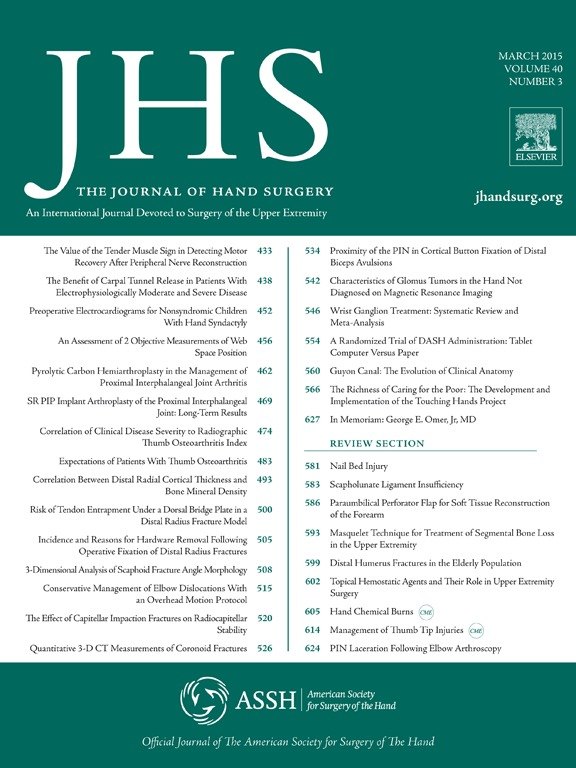
Comparable outcomes with long- & short-arm splinting for displaced distal radius fractures

Comparable outcomes with long- & short-arm splinting for displaced distal radius fractures
A Comparison of Immediate Postreduction Splinting Constructs for Controlling Initial Displacement of Fractures of the Distal Radius: A Prospective Randomized Study of Long-Arm Versus Short-Arm Splinting
J Hand Surg Am. 2006 May-Jun;31(5):766-70Synopsis
118 patients with displaced distal radius fractures were randomised to undergo either a long-arm sugar tong splinting intervention or a short-arm radial gutter splinting intervention. Radiographic outcomes and disability were observed. Results indicated that comparable outcomes were seen between the long- and short-arm groups. The author's recommend the use of the short-arm splint due to it's improved functionality compared to the long-arm splint.
Was the allocation sequence adequately generated?
Was allocation adequately concealed?
Blinding Treatment Providers: Was knowledge of the allocated interventions adequately prevented?
Blinding Outcome Assessors: Was knowledge of the allocated interventions adequately prevented?
Blinding Patients: Was knowledge of the allocated interventions adequately prevented?
Was loss to follow-up (missing outcome data) infrequent?
Are reports of the study free of suggestion of selective outcome reporting?
Were outcomes objective, patient-important and assessed in a manner to limit bias (ie. duplicate assessors, Independent assessors)?
Was the sample size sufficiently large to assure a balance of prognosis and sufficiently large number of outcome events?
Was investigator expertise/experience with both treatment and control techniques likely the same (ie.were criteria for surgeon participation/expertise provided)?
Yes = 1
Uncertain = 0.5
Not Relevant = 0
No = 0
The Reporting Criteria Assessment evaluates the transparency with which authors report the methodological and trial characteristics of the trial within the publication. The assessment is divided into five categories which are presented below.
2/4
Randomization
2/4
Outcome Measurements
3/4
Inclusion / Exclusion
4/4
Therapy Description
4/4
Statistics
Detsky AS, Naylor CD, O'Rourke K, McGeer AJ, L'Abbé KA. J Clin Epidemiol. 1992;45:255-65
The Fragility Index is a tool that aids in the interpretation of significant findings, providing a measure of strength for a result. The Fragility Index represents the number of consecutive events that need to be added to a dichotomous outcome to make the finding no longer significant. A small number represents a weaker finding and a large number represents a stronger finding.
Why was this study needed now?
There is a lack of agreement in the medical community on the method of treating distal radius fractures. The forearm immobilization intervention is one of the most controversial treatment methods as it has produced conflicting data from studies. This present study examines the outcomes of long-arm and short-arm splinting in treating displaced distal radius fractures.
What was the principal research question?
What are the radiographic and disability outcomes when patients with displaced distal radius fractures undergo a long-arm sugar tong splinting intervention compared to a short-arm radial gutter splinting intervention at 13 months?
What were the important findings?
- There was a loss of fracture reduction observed at the initial 8-day follow-up in 33 fractures. In the short-arm radial gutter splint group, 16/38 fractures were displaced compared to 17/47 fractures from the long-arm sugar tong splint group. However, this difference was not significant. (p=0.58)
- No significant differences were seen between the splint's ability to maintain fracture reduction in stable and unstable displaced fractures when evaluated for fracture stability. (p=0.78)
- No significant difference was seen in rate of reduction loss between the groups. (p=0.32)
- Better outcomes in the DASH score was seen in the short-arm group (62+-19) compared with those in the long-arm group (70+-15) at one week. (p=0.044)
What should I remember most?
Comparable outcomes were seen in the long-arm sugar tong splint group and the short-arm radial gutter splint group in initial reduction maintenance. The authors of this study recommend the short-arm splint for initial immobilization due to its reduced functional limitations compared to the long-arm splint.
How will this affect the care of my patients?
Patients may find the short-arm splint more functionally tolerable compared to the long-arm splint. However, the outcomes in reduction maintenance and disability were comparable with both interventions.
Learn about our AI Driven
High Impact Search Feature
Our AI driven High Impact metric calculates the impact an article will have by considering both the publishing journal and the content of the article itself. Built using the latest advances in natural language processing, OE High Impact predicts an article’s future number of citations better than impact factor alone.
Continue



 LOGIN
LOGIN

Join the Conversation
Please Login or Join to leave comments.
Orthopaedic Surgeon - Canada
short is better